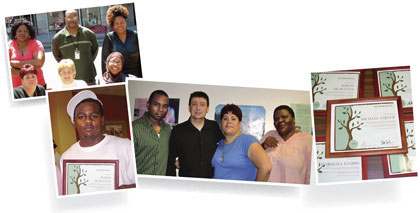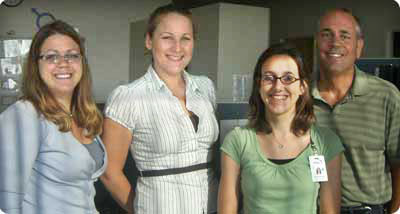 |

In Upstate New York: Success
In Rochester, Huther-Doyle
Memorial
Institute has seen recidivism rates
plummet. According to Ms. Urban, the recidivism rate was 80 percent
before the Young Offender Reentry Program
came along. Today, the rate is just
14 percent for the 18- to 24-year-olds
the Rochester program targets. |
Even better, Ms. Urban added, when
clients are arrested again, it’s
typically for less serious crimes than
whatever it was that got them incarcerated
in the first place.
“My glass is always half full,” said
Ms. Urban, noting that committing a
minor crime rather than a major one
is a step in the right direction even
if the client lands back in jail. “One
of the things this program has done
is to keep these young people from
graduating to the big leagues, where
they end up going to prison.”
The program’s case managers
begin working with youth 3 to 6 months
before their release. In addition to
conducting assessments, the case managers
analyze each client’s strengths,
weaknesses, opportunities, and threats.
Together the case manager and client
then develop a transition plan based
on that analysis. “The transition
plan is a roadmap for what they need
to do when they get out,” explained
Ms. Urban. “That way they know
what’s going to happen—even
where they’re going to get their
first meal.”
 |
|
 |
|
In
Rochester, NY, Huther-Doyle Memorial
Institute’s YORP staff
include (top left to bottom right)
Helen Warnick, Jeff Bookhart,
Tamekia Ransom, Maria Quinones,
Cheryl Orefice, and Project Coordinator
Tisha Smith. Bottom left photo:
Graduate Byron McMullen. Center
photo (left to right) Rahsann
Eaton, Counselor, Monroe County
Corrections; Craig Johnson, Director
of Programming, Monroe County
Corrections; and Case Managers
Maria Quinones and Helen Warnick. |
Building trusting relationships among
offenders and the five case managers
is another emphasis of pre-release
activities. There are basketball teams
and current event groups. The project
coordinator working onsite at the
jail has even created a newsletter
highlighting the young offenders’ progress,
poetry, and artwork. Noting that many
participants are gang members, Ms.
Urban explains that the goal is to
create an alternative family.
The moment the young people are released,
the case managers jump into action. “Case
managers pick them up on release day,
whether it’s 6 in the morning
or midnight,” explained Ms. Urban.
The client then spends up to a year
in the program, earning a GED, getting
substance abuse or mental health treatment,
learning how to interview for a job—whatever
will help them stay out of trouble.
“We want to show them that there’s
something other than selling drugs
and hanging out on the street corner,” said
Ms. Urban.
Back
to Top
In Florida: Recovery Begins Right
Away
In Pinellas Park, FL, Operation PAR,
Inc., is having a big impact on the
14- to 18-year-old offenders it serves.
Working closely with the agency that
oversees young offenders’ probation
and aftercare requirements, Operation
PAR starts its Young Offender Reentry
Program as soon as teens are released.
The results are impressive, said Tommi
L. Leveille, Administrator of Research
and Evaluation at Operation PAR. For
youth who complete the full 8 to 12
weeks of treatment, more than 50 percent
were in recovery at the 6-month followup.
Of those who completed only part of
the treatment, the recovery rate was
only 20 percent.
Even more importantly, youth who completed
the program had much lower recidivism
rates, Ms. Leveille said. A total of
54 percent of those who completed the
program had managed to stay out of
trouble by the 6-month followup, compared
to just 30 percent of those who completed
only part of the treatment.
A continuous feedback loop helps.
At the beginning, for instance, the
program’s three counselors had
a hard time persuading families to
let them come to their homes for family
therapy and case management. The problem,
it turned out, was the use of the word “home
visits,” which is what the state’s
child welfare department calls its
investigations. Changing the terminology
to “touching base” or “dropping
by” was enough to improve engagement,
explained Ms. Leveille.
“These adolescents have spent
anywhere from 1 to 5 years in the juvenile
justice system and aren’t equipped
with the skills they need to live successful
lives,” Ms. Leveille said. “We
teach them the skills they need.”
For more information on criminal justice
programs at SAMHSA, visit www.samhsa.gov. 
 |
 |
(Left
to right) Staff members Ashley
Corlett, Susie Bream, Danielle
Schiller, and Brian Constantine. |
« Part 1:
Helping Young Offenders Return to Communities
See
Also—Helping Young Offenders Return to
Communities
What Works? »
Grantees List »
Administrator’s
Message: Reducing Substance Use, Reducing Recidivism »
Next
Article »
Back
to Top
|






